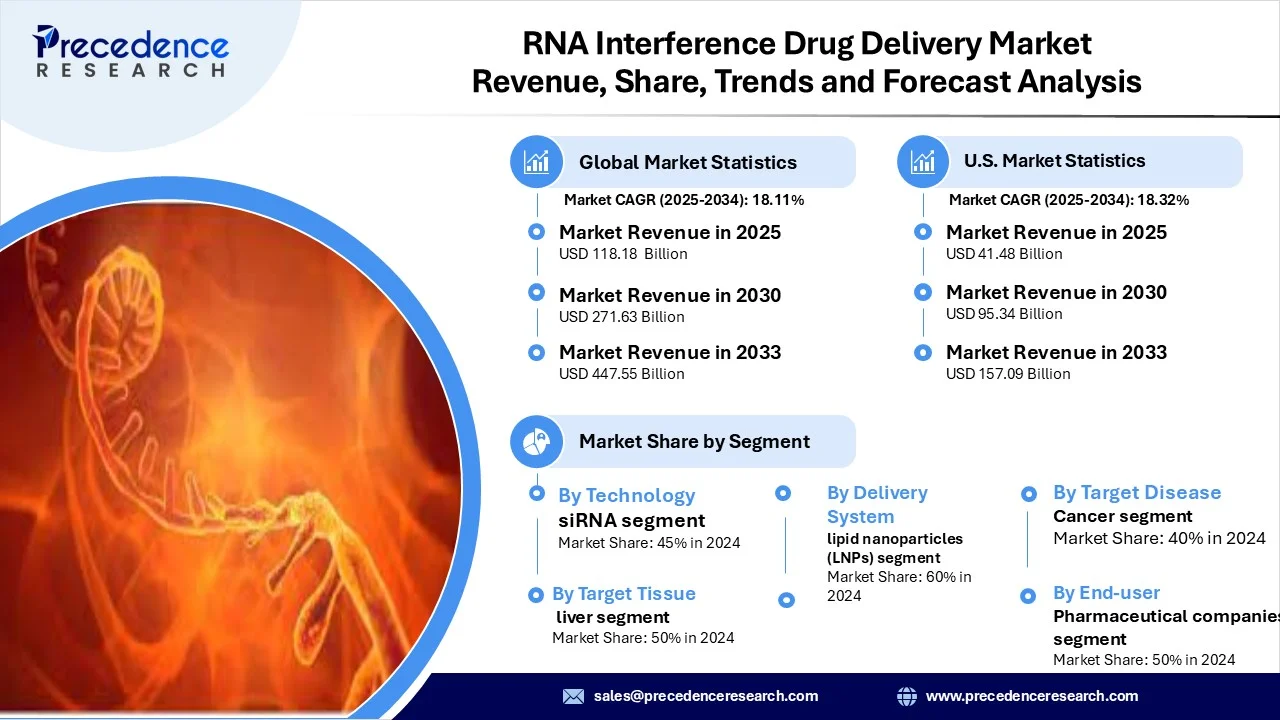RNA Interference Drug Delivery Market Revenue to Attain USD 447.55 Bn by 2033
RNA Interference Drug Delivery Market Revenue and Trends 2025 to 2033
The global RNA interference drug delivery market revenue reached USD 118.18 billion in 2025 and is predicted to attain around USD 447.55 billion by 2033 with a CAGR of 18.11%. The RNA interference drug delivery market is driven by advancements in gene-silencing technologies and increasing adoption of targeted RNA-based therapeutics.

Expanding the Horizons of RNA Interference Drug Delivery
The RNA interference (RNAi) drug delivery domain is evolving rapidly due to improvements in genetics and science, increasing demand for targeted therapies and growth of RNAi-drug delivery technologies used in oncology and rare disease states. RNA interference is described as a biological process by which RNA molecules inhibit gene expression or translattion, ultimately silencing genes that enable diseases to progress.
The expansion in the RNA interference drug delivery domain is also highlighted by specificity and stability of RNA-based therapies imparted by advances in lipid nanoparticles, polymer-based carriers, and deliver systems using conjugates. Increased investment from both small, medium and large pharmaceuticals in the development of RNAi-drug therapies, and recent emergence of FDA approved new drugs based on RNAi continue to validate that RNA interference will change the future of precision medicine and gene targeted therapy.
Segmental Analysis
- By Technology- Due to its ability to selectively silence genes, clinical track record of successful deployment, and increasing number of FDA-approved siRNA-based therapies for genetic diseases and orphan diseases, small interfering RNA (siRNA) technology is the leader in the market.
- By Delivery System- Lipid nanoparticles deliver the most effective and efficient carrier systems for RNA-based therapeutics combining properties of RNA stability, efficiency of targeted delivery, and biocompatibility for systemic dosing and liver delivery.
- By Route of Administration- Intravenous routes of administration is the leading pathway as it can provide high bioavailability of drug, rapid distribution throughout the body, and directly deliver RNA-based drugs to targeted tissues or organs.
- By Target Disease- Cancer is the primary target disease area as there continues to be significant uptake of RNAi drugs to inhibit oncogenes and further a trajectory towards precision oncology, all supported by a number of clinical trials targeting specific oncogenes in tumors.
- By Target Tissue- The liver is the primary tissue being targeted because the vast majority of approved RNAi therapeutics are approved for liver specific diseases and the liver has a unique ability to uptake lipid-based formulations of RNA.
- By End User- Pharmaceutical companies represent the primary end user where a vast amount of R&D, collaboration, and intensive commercialization plans continue around RNA interference-based products worldwide.
Regional Analysis
The RNA interference drug delivery market is led by North America because of its large ecosystem of academic research institutions, biotech startups, and well-known pharmaceutical companies. Strong translational infrastructure and fund-able clinical programs with learner regulatory pathways advance formulation development and commercialization. Strong venture capital, public funding and established manufacturing and CRO networks will produce rapid scale up and partnerships to help maintain the region's position in clinical advancement.
Asia Pacific is the fastest growing region for RNA interference, delivery budding biotech hubs and growing R&D investments, primarily across China, India, Japan and South Korea. Lower development costs and government incentives encourage more local ventures and partnerships with globally established companies. Fast expanding clinical trial network, more manufacturing capacity, and larger patient populations create more opportunity for faster testing and wider adoption of RNA interference. Increasing cross-border collaborations and increased legal licensing deals further propels the market growth.
RNA Interference Drug Delivery Market Coverage
| Report Attribute | Key Statistics |
| Market Revenue in 2025 | USD 118.18 Billion |
| Market Revenue by 2033 | USD 447.55 Billion |
| CAGR from 2025 to 2033 | 18.11% |
| Quantitative Units | Revenue in USD million/billion, Volume in units |
| Largest Market | North America |
| Base Year | 2024 |
| Regions Covered | North America, Europe, Asia-Pacific, Latin America, and the Middle East & Africa |
Recent Developments
- In October 2025, Aerska, a biotechnology company aiming to redefine the treatment of neurological diseases, announced raised $21 million investment in seed financing, co-led by Age1, Backed VC and Speedinvest, to develop RNAi medicines for diseases of the brain. (Source: https://www.globenewswire.com)
Key Players in RNA Interference Drug Delivery Market
- Alnylam Pharmaceuticals
- Arrowhead Pharmaceuticals
- Dicerna Pharmaceuticals (Acquired by Novo Nordisk)
- Silence Therapeutics
- Ionis Pharmaceuticals
- Arcturus Therapeutics
- Moderna, Inc.
- CureVac AG
- GSK plc
- Sanofi
Get this report to explore global market size, share, CAGR, and trends, featuring detailed segmental analysis and an insightful competitive landscape overview @ https://www.precedenceresearch.com/sample/6979
You can place an order or ask any questions, please feel free to contact us at sales@precedenceresearch.com |+1 804 441 9344